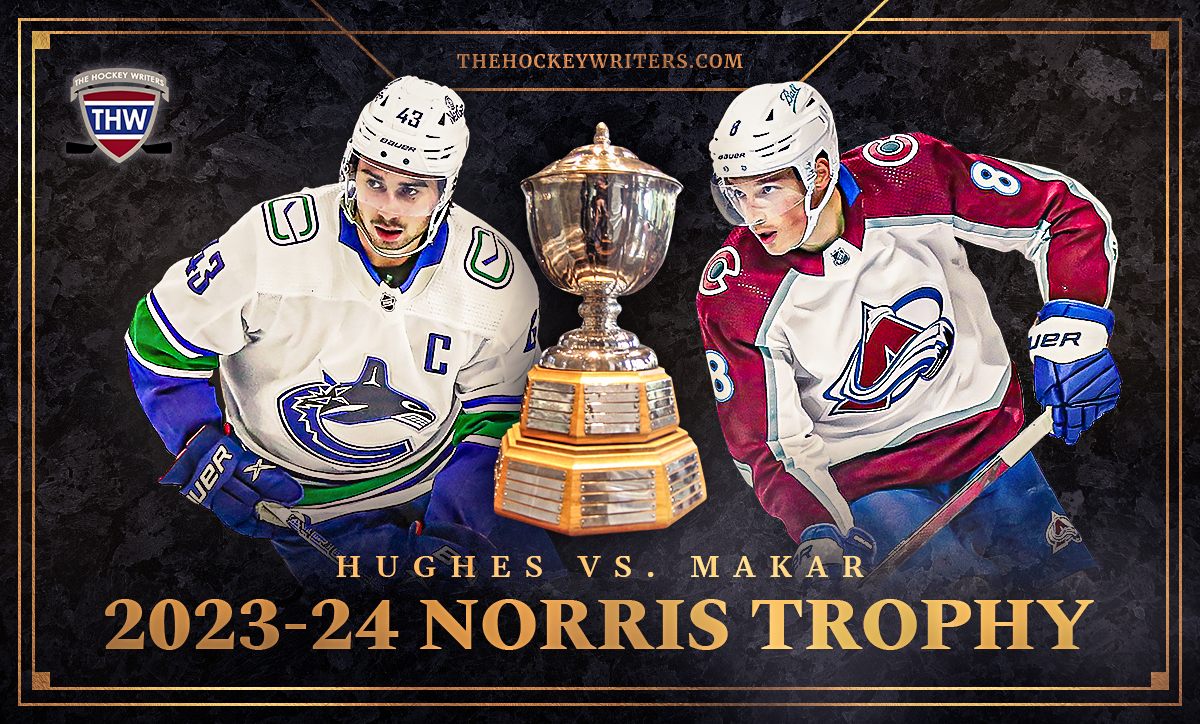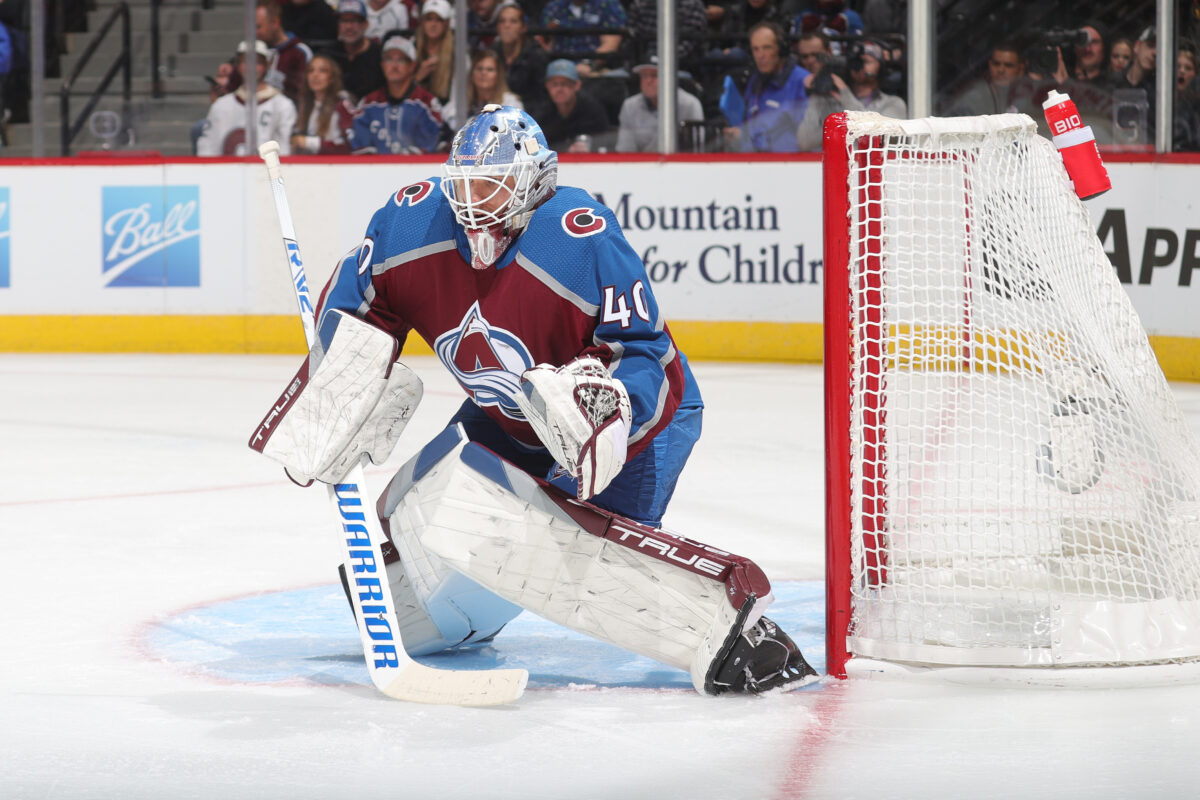All things considered, the Colorado Avalanche have to be content with how the season has unfolded as the calendar turns to 2024. Despite navigating extensive injury troubles – they rank fifth in the NHL by cumulative Cap Hit of Injured Players (CHIP) – the club remains within striking distance of all three of the Central Division crown, the regular-season Western Conference title, and the Presidents’ Trophy.
A .671 points percentage (PTS%) after 41 games puts the Avalanche on pace for 110 points, one more point than they accrued during the 2022-23 season. It should be noted that they also ranked fifth by CHIP last season, and still managed to win their division by a single point over the Dallas Stars.
The 2023-24 season has been one of peaks and valleys in the way of on-ice results. The team started the season by winning its first six games, experienced some turbulence in going 13-10-2 over their next 25 matchups, and have now gone 7-2-1 over their last 10 games. In spite of it all, they’re running at about the same clip as last season, and have their sights set on capturing the fourth Stanley Cup in franchise history.
So, which players have been driving the team’s on-ice fortunes this season? Which statistical trends have defined the 2023-24 campaign to date? Let’s dive in and find out.
MacKinnon Grabbing Lead in 2023-24 Hart Trophy Race
It’s no surprise that Nathan MacKinnon has never won the Hart Trophy as the NHL’s MVP given that his career has overlapped with the reigns of Sidney Crosby and Alexander Ovechkin, as well as the dawn of the Connor McDavid experience. He was a finalist in both 2017-18 and 2018-19, but hasn’t returned to the top three since.
MacKinnon got off to a quiet start to this season by his standards, only tallying four goals and nine points in nine games. Since Nov. 1, he’s scored at will, leading the league with 39 assists and 57 points in 32 games, capped by a 19-game point streak. Tampa Bay Lightning winger Nikita Kucherov is his closest challenger for both the Hart and the Art Ross. The Russian forward sits one point ahead of MacKinnon with 67 points in 40 games, though the Avalanche center leads all skaters with 39 even-strength points.

Though MacKinnon boasts the statistical profile that usually belongs to an MVP, the conversation often revolves around a player’s supporting cast.
Detractors might point out that defenseman Cale Makar leads all blueliners in points-per-game (1.33) while winger Mikko Rantanen sits within the top 15 of NHL skaters by goals (21) and points (51). Still, the discrepancy is seen between the stars and the depth where, after Valeri Nichushkin and his 40 points in 39 games, Jonathan Drouin ranks fourth among Avalanche forwards with 21 points in 39 games.
MacKinnon is undoubtedly buoyed by the presence of Rantanen and Makar – two of his three most common linemates at five-on-five – but the brunt of the team’s scoring falls on his shoulders. Bolstering the forward depth from the second line down should be the Avalanche’s priority before the trade deadline.
Avalanche Finding Success with Special Teams
The two components of special teams play – the power play and the penalty kill – can drive major swings in on-ice results, even overpowering the greater sample size of five-on-five play. In the Avalanche’s case, both of their special teams units rank within the top 10 of their respective categories, with the club firing at a 24.4% conversion rate on the power play (eighth), and killing 82.4% of all penalties (10th).
You may also like:
- Winnipeg Jets’ Keys to Success in Games 3 and 4
- Jets’ Goaltending Advantage Against Avalanche Hasn’t Materialized
- Former New York Islanders in the 2024 Stanley Cup Playoffs
- Avalanche in Control of Series Against the Jets Going into Game 3
- Avalanche Are Good Enough to Win Without Quality Goaltending
The Avalanche have struggled to generate a ton of volume (18th in scoring chances for per-60-minutes) or quality (16th in high-danger chances per-60) with the man-advantage, but skilled finishers such as Rantanen and MacKinnon help bridge that gap.
Colorado’s penalty kill hasn’t relied on hot goaltending to achieve its high ranking. They rank fifth in shots against per-60 and eighth in scoring chances against per-60 while shorthanded, showing that good process is driving their success.
Special teams play takes on greater importance during the smaller sample of a seven-game playoff series, so having reliable tools to wield in such situations is an underrated strength and should work in the Avalanche’s favour.
Makar Battling Canucks’ Hughes for 2023-24 Norris Trophy
Hinted at in the previous section, the battle between Makar and the Vancouver Canucks’ Quinn Hughes for the 2023-24 Norris Trophy is shaping up to be an all-timer. Hughes leads all rearguards in total assists (40) and points (51) and sits second in goals (11), though Makar ranks first by assists (1.08) and points-per-game.
Makar (13th) and Hughes (20th) both sit inside the top 20 all-time of single-season rates of production (minimum 36 games played). If they maintain their current pace, they could join Bobby Orr (six times), Paul Coffey (seven), Denis Potvin (twice), Al MacInnis (once), Brian Leetch (once), and Ray Bourque (once) as the only defenders to ever pass the 1.25 points-per-game threshold, quite legendary company for the two blueliners.

Makar (10th in average ice time) and Hughes (14th) are both playing heavy minutes in all situations as their teams lean on them to leverage their skating and playmaking abilities. Although, the Avalanche star is averaging just under three minutes a game on the penalty kill while Hughes is a secondary shorthanded option for the Canucks (47 seconds per game). With everything else holding steady, that could sway the final votes in Makar’s direction.
Both players have steered their clubs to a spot in the top five of the overall league standings, and could be on a collision course to meet in the Western Conference playoffs. With their statistical resumés looking very similar, team success could be the tiebreaker. I’d hate to be a voter this season, as one historic performance is guaranteed to go unrecognized.
Avalanche’s Offseason Acquisitions Not Meeting Expectations
The Avalanche underwent a facelift this past offseason, with general manager Chris MacFarland bringing in a number of new names to replace the outgoing bodies. Ross Colton and Ryan Johansen were acquired to fill the hole at second-line center, while Jonathan Drouin and Miles Wood were targeted to improve the team’s winger depth, albeit for different reasons. Playmaker Tomas Tatar was signed following a preseason tryout with the hope of striking gold via the bargain bin. Through 41 games, those players have enjoyed varying degrees of success.
Colton and Johansen have alternated in the seemingly cursed second-line center spot, with neither player staking an undeniable claim to the role. Colton has scored eight goals and 17 points in 39 games while Johansen has tallied 11 goals and 16 points in 41 games, though Colton counts 16 even-strength points to Johansen’s 10. The former Lightning forward has outperformed Johansen at even strength, but he’s more of a third-line center in an ideal world.
Drouin initially failed to stick alongside his long-time friend MacKinnon on the first line, but has found a niche on the power play and is earning the trust of the coaches while playing further down the lineup. He’s scored nine goals and 20 points in 31 games since Nov. 1 after only tallying a single point across all of October. He’s also seen his average time on ice go from 13:16 per game in October, to 16:56 per game since the start of November and 18:57 since Dec. 1. Some of that bump is due to a significant injury to Artturi Lehkonen, but Drouin deserves the praise nonetheless.
Wood has scored six goals and 12 points in 39 games while accumulating 57 penalty minutes (PIMs) which is a bit underwhelming for paying $2.5 million per season. Still, he’s a strong forechecker and draws about as many minor penalties as he takes, so he grades out as a net-neutral. With a devastating power play, drawing a lot of penalties can swing the momentum in your team’s favor more often than not.
Tatar struggled with the pace of the Avalanche system and failed to carve out a role while only scoring one goal and nine points in 27 games. He has since been traded to the Seattle Kraken for a late-round draft pick, where he’s seen an uptick in production with five points in nine games.
Having to scavenge for bargains means that not every find is going to be golden. While Tatar was a low-risk swing, Johansen and his $4 million cap hit are going to be more difficult to address. He may be used as a salary makeweight in a future trade for a top-six center, but his often plodding play has reduced his value as an asset.
With the Avalanche’s Cup window shrinking with every passing year and not many top prospects in the pipeline, the team’s stars must be given a stronger supporting cast.
Avalanche Goaltending Hitting a Rough Patch
The Avalanche’s goaltending was a major strength last season with the team’s .912 save percentage (SV%) in all situations ranking sixth league-wide.
Newcomer Alexandar Georgiev submitted a dark-horse Vezina Trophy campaign by making 62 starts (third among all goalies), winning 40 games (tied-first), and posting a .919 SV% (tied-seventh; minimum 10 games played). Even Pavel Francouz (missing the entire 2023-24 season through injury) was steady in a backup role, boasting a .915 SV% in 16 games.
The script has been flipped in 2023-24 as Colorado sits 25th overall with a team SV% of .890. Georgiev’s numbers have plummeted in his sophomore campaign with the Avalanche. He leads the league in starts (33) and wins (22), but both his SV% (.895) and goals-against average/GAA (2.97) both rank within the bottom half among all qualified goalies (minimum 10 games played).

This year’s backup – Ivan Prosvetov – boasts a record of 4-3-1 in 11 games, but has also posted subpar individual numbers with a .895 SV% and a 3.16 GAA. Both goalies own positive marks by goals saved above expected (GSAx), but the traditional boxscore numbers don’t paint a pretty picture.
The Avalanche have managed to outscore their problems in the crease (second in goals for per game), but most Stanley Cup champions can count on stability in the crease. If Georgiev can’t regain his 2022-23 form, the front office must go searching for reinforcement in net.
Avalanche Must Finish Strong in Second Half of 2023-24 Season
For all of the rightful hand-wringing over certain players and on-ice results, the Avalanche still occupy a similar place in the NHL’s competitive hierarchy as they did at the beginning of the 2023 offseason.
Still, two of the league’s top three teams and six of the top 10 by PTS% hail from the Western Conference, including the Avalanche. The balance of power has swung away from the East which makes the Avalanche’s eventual trek through the postseason all that much harder.
Clinching home-ice advantage could be the difference between failing to advance past the opening rounds and emerging victorious in June, especially with Colorado currently boasting a middling 9-7-3 record away from home.
Given that the Avalanche own the second-best regular-season PTS% (.690) since the start of the 2021-22 season, they deserve the benefit of the doubt. That shouldn’t supersede finding both internal and external avenues to improve a Cup-worthy roster.
Data courtesy of Evolving Hockey, Natural Stat Trick, and the NHL.
